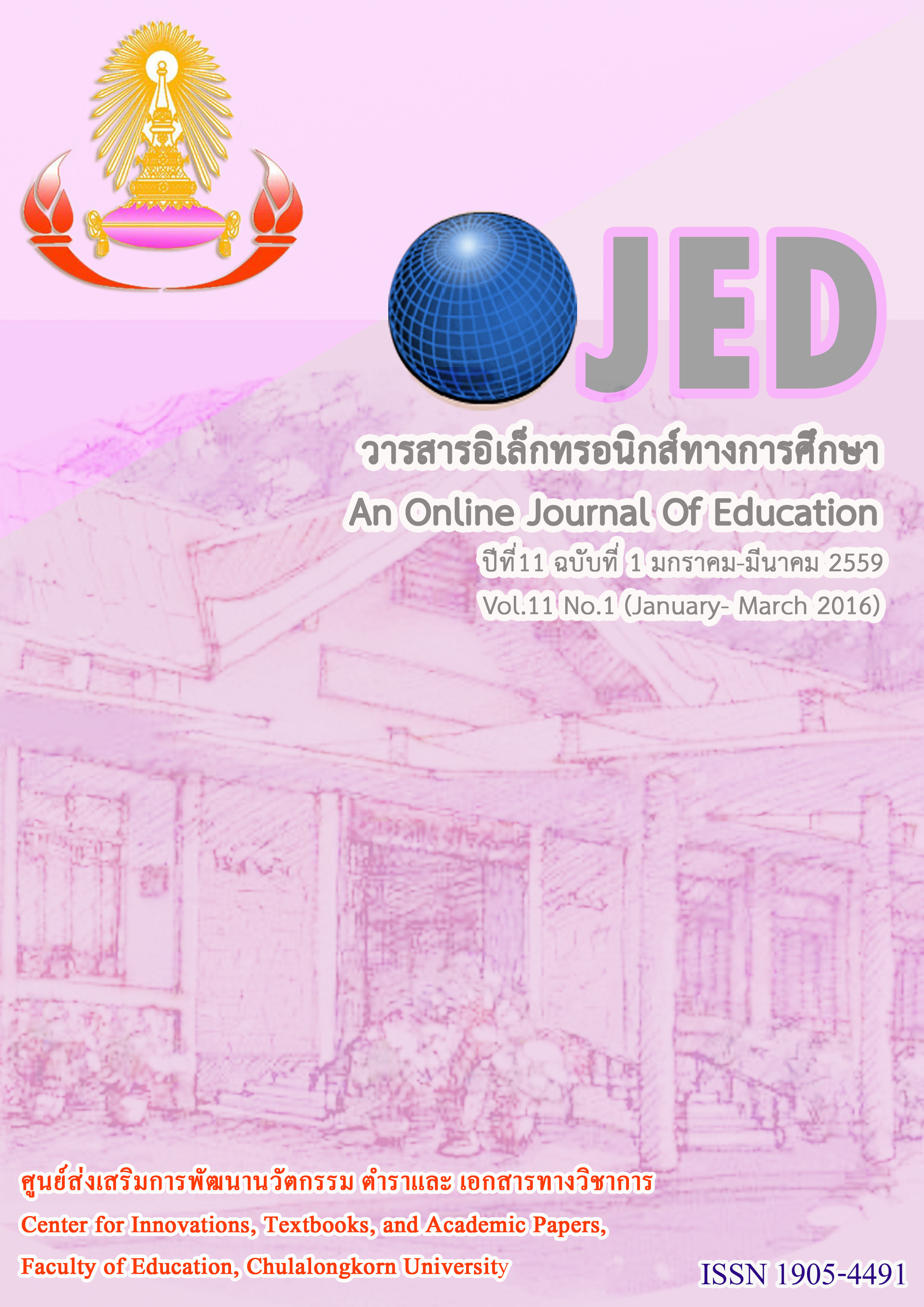ผลของการเล่านิทานโดยใช้ผังความคิดตามแนวคิดของโทนี่ บูซาน ที่มีต่อการเข้าใจความของเด็กอนุบาล EFFECTS OF STORY TELLING USING MIND MAP BASED ON THE TONY BUZAN’S APPROACH ON COMPREHENSION OF KINDERGARTENERS
Keywords:
การเล่านิทาน, ผังความคิด, การเข้าใจความ, เด็กอนุบาล, STORY TELLING, MIND MAP, COMPREHENSION, KINDERGARTENERSAbstract
การวิจัยครั้งนี้มีวัตถุประสงค์ 1) เพื่อศึกษาผลของการเล่านิทานโดยใช้ผังความคิดตามแนวคิดของโทนี่ บูซาน ที่มีต่อการเข้าใจความของเด็กอนุบาลใน 4 ด้าน ได้แก่ ด้านการบอกรายละเอียด ด้านการลำดับเหตุการณ์ ด้านการบอกถึงเหตุและผล และด้านการจับใจความสำคัญ 2) เพื่อเปรียบเทียบผลของการเล่านิทานโดยใช้ผังความคิดตามแนวคิดของโทนี่ บูซาน และการเล่านิทานแบบปกติที่มีต่อการเข้าใจความของเด็กอนุบาล กลุ่มตัวอย่าง คือ เด็กชั้นอนุบาลปีที่ 2 ปีการศึกษา 2558 โรงเรียนวัดด่านสำโรง สังกัดสำนักงานเขตพื้นที่การศึกษาประถมศึกษา สมุทรปราการ เขต 1 จำนวน 32 คน โดยแบ่งเป็นกลุ่มทดลอง จำนวน 16 คน และกลุ่มควบคุม จำนวน 16 คน ซึ่งได้มาจากการสุ่มตัวอย่างแบบเจาะจงและการสุ่มอย่างง่าย กลุ่มทดลองได้รับการเล่านิทานโดยใช้ผังความคิดตามแนวคิดของโทนี่ บูซาน ประกอบด้วย 3 ขั้นตอน ได้แก่ ขั้นที่ 1 การพัฒนาหัวเรื่อง ขั้นที่ 2 การเล่านิทาน และขั้นที่ 3 การปฏิบัติ ส่วนกลุ่มควบคุมได้รับการเล่านิทานแบบปกติ ระยะเวลาที่ใช้ในการทดลอง 10 สัปดาห์ เครื่องมือที่ใช้ในการวิจัย คือ แบบวัดการเข้าใจความของเด็กอนุบาล วิเคราะห์ข้อมูลโดยหาค่าเฉลี่ย ส่วนเบี่ยงเบนมาตรฐาน และการทดสอบค่าที
ผลการวิจัยพบว่า 1) หลังการทดลอง กลุ่มทดลองมีค่าเฉลี่ยคะแนนการเข้าใจความ ด้านการบอกรายละเอียด ด้านการลำดับเหตุการณ์ ด้านการบอกถึงเหตุและผล และด้านการจับใจความสำคัญ สูงกว่าก่อนการทดลองอย่างมีนัยสำคัญทางสถิติที่ระดับ .01 2) หลังการทดลอง กลุ่มทดลองมีค่าเฉลี่ยคะแนนการเข้าใจความ ด้านการบอกรายละเอียด ด้านการลำดับเหตุการณ์ ด้านการบอกถึงเหตุและผล และด้านการจับใจความสำคัญ สูงกว่ากลุ่มควบคุมอย่างมีนัยสำคัญทางสถิติที่ระดับ .01
The purpose of this research were to 1) study the effects of storytelling using a mind map based on Tony Buzan’s approach on the comprehension of kindergarteners in 4 aspects: identifying details, the sequencing of events, telling cause and effect, and identifying main ideas; and to 2) compare the effects of storytelling using a mind map based on Tony Buzan’s approach on comprehension between an experimental group and a control group. The samples were 32 kindergarteners of K.2 at Watdansamrong School under the jurisdiction of the Samut Prakan Provincial Primary Education Service Area Office. The samples were divided into two groups; 16 children for the experimental group and 16 children for the control group, who were selected by purposive and simple random sampling. The experimental group used storytelling using a mind map based on Tony Buzan’s approach, consisting of 3 steps: 1) developing a title, 2) telling a story, and 3) practicing, and the control group used conventional storytelling. The research duration was 10 weeks. The research instrument was the assessment form of kindergarteners’ comprehension. The data was statistically analyzed by using arithmetic mean, standard deviation and t-test. The research results were as follows: 1) After the experiment, the experimental group had higher mean scores than before the experiment of comprehension in 4 aspects: identifying details, sequencing of events, telling cause and effect, and identifying main ideas, at a .01 significance level. 2) After the experiment, the experimental group had higher mean scores than that of the control group of the comprehension of 4 aspects: identifying details, sequencing of events, telling cause and effect, and identifying main ideas, at a .01 significance level.




